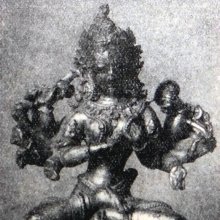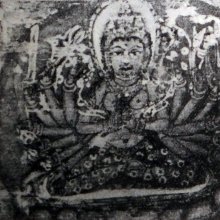Cundavajri, Cundavajrī: 1 definition
Introduction:
Cundavajri means something in Buddhism, Pali. If you want to know the exact meaning, history, etymology or English translation of this term then check out the descriptions on this page. Add your comment or reference to a book if you want to contribute to this summary article.
Alternative spellings of this word include Chundavajri.
Images (photo gallery)
In Buddhism
Tibetan Buddhism (Vajrayana or tantric Buddhism)
Source: archive.org: The Indian Buddhist IconographyCundavajrī (चुन्दवज्री) is another name for Cundā: one of the various emanations of Vairocana, as mentioned in the 5th-century Sādhanamālā (a collection of sādhana texts that contain detailed instructions for rituals).—Her Colour is white;her Symbol is the book on lotus; she has one face, and two, four, sixteen, eighteen or twenty-six arms.—According to the Niṣpannayogāvalī under the mañjuvajra-maṇḍala, Cundā is affiliated to the Dhyāni Buddha Vairocana, and thus Cundā is the spiritual daughter of Vairocana, and is required to be classed under the emanations of this very Dhyāni Buddha.

Tibetan Buddhism includes schools such as Nyingma, Kadampa, Kagyu and Gelug. Their primary canon of literature is divided in two broad categories: The Kangyur, which consists of Buddha’s words, and the Tengyur, which includes commentaries from various sources. Esotericism and tantra techniques (vajrayāna) are collected indepently.
See also (Relevant definitions)
Full-text: Cunda.
Relevant text
Search found 1 books and stories containing Cundavajri, Cundavajrī; (plurals include: Cundavajris, Cundavajrīs). You can also click to the full overview containing English textual excerpts. Below are direct links for the most relevant articles:
The Indian Buddhist Iconography (by Benoytosh Bhattachacharyya)



